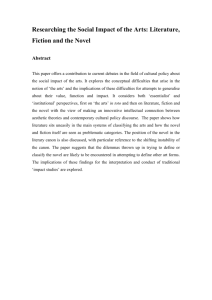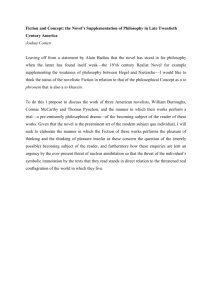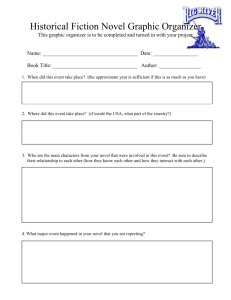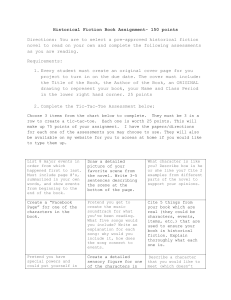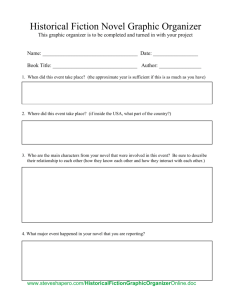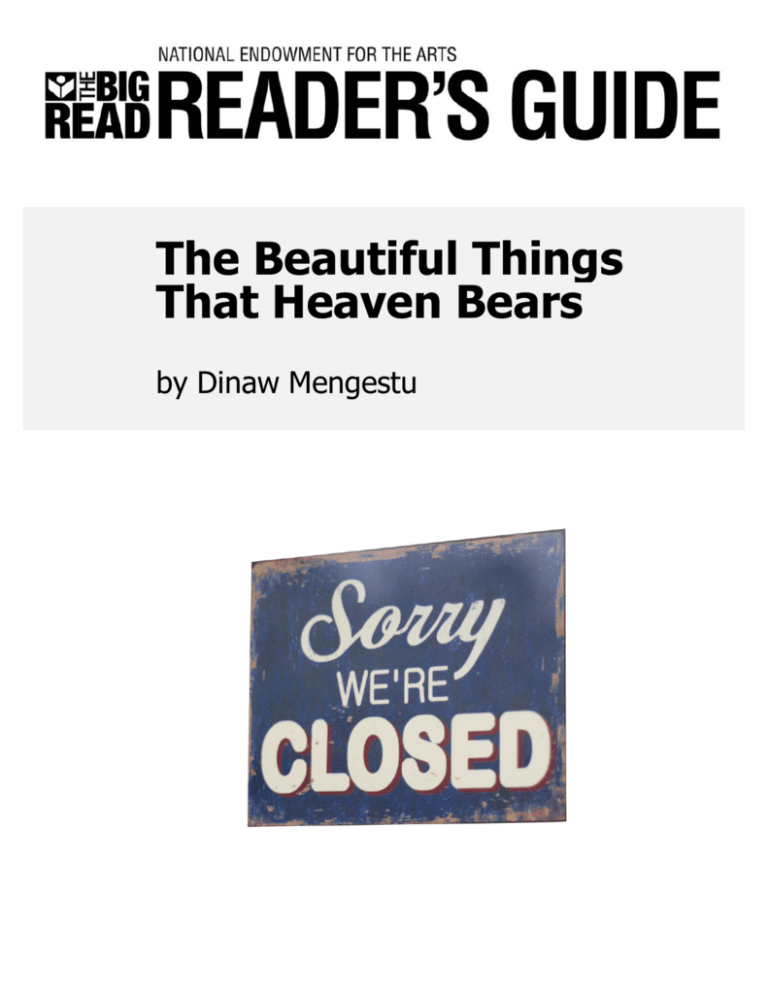
The Beautiful Things
That Heaven Bears
by Dinaw Mengestu
1
Table of Contents
The Beautiful
Things That
Heaven Bears
About the Book.................................................... 3
About the Author ................................................. 5
Historical and Literary Context .............................. 7
Other Works/Adaptations ..................................... 9
Discussion Questions.......................................... 10
Additional Resources .......................................... 11
Credits .............................................................. 12
Preface
Indicates interviews with the author and experts on this
book. Internet access is required for this content.
In a review of Dinaw Mengestu's first novel, The Beautiful
Things That Heaven Bears, the New York Times called it “a
great African novel, a great Washington novel and a great
American novel.” Sepha Stephanos narrates his experiences
across these worlds as an Ethiopian immigrant shopkeeper
in a predominantly poor African-American neighborhood in
Washington, DC. Blending humor with sadness and layering
the present with images from the past, Mengestu charts
Stephanos's heartbreaking loneliness, his companionship
with two fellow African immigrants who mourn and love their
countries, and his budding friendship with a young girl and
her mother who recently moved into the gentrifying
neighborhood. This is a subtly rendered novel, combining
despair with hints of the beautiful things in life.
To listen to Willing Davidson, a fiction editor at The New
Yorker, talk about this debut novel visit
http://www.neabigread.org/books/beautifulthings/#debut
“The stories he
invented himself he
told with particular
delight. They all
began in the same
way, with the same
lighthearted tone,
with a small wave of
the hand, as if the
world were being
brushed to the
side…”
What is The Big Read?
A program of the National Endowment for the Arts, The Big
Read broadens our understanding of our world, our
communities, and ourselves through the joy of sharing a
good book. Managed by Arts Midwest, this initiative offers
grants to support innovative community reading programs
designed around a single book.
A great book combines enrichment with enchantment. It
awakens our imagination and enlarges our humanity. It can
offer harrowing insights that somehow console and comfort
us. Whether you’re a regular reader already or making up
for lost time, thank you for joining The Big Read.
2
About the Book
Introduction to
the Novel
In this novel, Dinaw Mengestu
describes the pain of exile,
when one is violently uprooted
from his or her homeland.
Having fled the Ethiopian Red
Terror of the late 1970s to live
and work in Washington, DC,
Sepha Stephanos is acutely
aware of the loneliness,
sadness, and dislocation that
accompany his pursuit to find a
quiet refuge from the ghosts of
his old life. Seventeen years
have passed since Stephanos immigrated to Washington,
where he began working as a hotel valet and met his two
companions, also African immigrants, “Joe from the Congo”
and “Ken the Kenyan.”
Logan Circle, tensions arise, and Stephanos's relationships
with both Judith and Naomi become precarious.
Alternating from past to present, the novel poses questions
not only about the immigrant experience in America and the
fraught nature of attaining the American dream, but also
about the complex nature of various displacements: from
one's country, one's past, one's prior ambitions, and one's
lost loves.
Dinaw Mengestu and his sister, Bezawit (Courtesy of
the Mengestu family)
Meeting weekly in Stephanos's neighborhood grocery to
reminisce about their pasts, they play a bitterly absurd game
matching African dictators with countries and coups. Their
friendship is a way to navigate living in between two worlds:
the Africa they left behind in the midst of war, and the
America they never feel at home in. Stephanos meets Judith,
an American history professor, and her biracial daughter
Naomi, when they move in next door. As Judith renovates
the four-story brick mansion, Stephanos builds a friendship
with Naomi, who visits his failing shop and transforms the
quiet, somber space to a haven of imaginative storytelling
and reading Dostoyevsky's The Brothers Karamazov aloud.
However, as Judith becomes part of the gentrification
process that displaces longtime residents of DC's decaying
3
Major Characters in the Novel
Sepha Stephanos
After he watches his father beaten and kidnapped by
soldiers, Stephanos flees Ethiopia to the United States. He
opens a shabby local grocery in Logan Circle and lives a very
quiet and lonely life, haunted by his past.
To listen to Dinaw Mengestu talk about Sepha
Stephanos, visit
http://www.neabigread.org/books/beautifulthings/readersguide/#Sepha
Kenneth
“Ken the Kenyan” is a smartly dressed engineer and one of
Stephanos's two close friends. He encourages Stephanos to
be ambitious in his new country.
Joseph
“Joe from the Congo” is a waiter at an expensive restaurant,
aptly called The Colonial Grill. His real passion is studying
literature. Even though he relinquished his dream of getting
his PhD, he's kept all his college books and quotes poetry to
illustrate a point.
Mrs. Davis
An elderly African-American woman, she is a longtime
resident of Logan Circle and is Stephanos's neighbor. She
represents the sizeable community concerned about recent
evictions due to rapid gentrification.
To listen to Urban Institute researcher Peter Tatian talk
about the dramatic changes Logan Circle has seen in recent
years, visit
http://www.neabigread.org/books/beautifulthings/readersguide/#LoganCircle
Uncle Berhane
Stephanos's "uncle" is a family friend and the only
connection Stephanos has to his family back home. He too
fled Ethiopia, leaving behind a more prosperous life, and
now lives in a small apartment in a densely populated
Ethiopian enclave in suburban DC.
To listen to Willing Davidson, a fiction editor at The New
Yorker, talk about Stephanos's African friends, visit
http://www.neabigread.org/books/beautifulthings/readersguide/#friends
Judith
A professor of nineteenth century American history, recently
separated from her husband, she moves to Logan Circle with
her daughter Naomi. Intent on creating a home for Naomi,
Judith meticulously restores a four-story brick mansion while
finding comfort and companionship with Stephanos.
To listen to Willing Davidson, a fiction editor at The New
Yorker, talk about Judith moving to Logan Circle, visit
http://www.neabigread.org/books/beautifulthings/readersguide/#Judith
Naomi
“Stubbornly independent,” and taking pride in being able to
chastise the world's shortcomings, Judith's eleven-year-old
biracial daughter develops a special friendship with
Stephanos.
To listen to Willing Davidson, a fiction editor at The New
Yorker, talk about Stephanos's friendship with Naomi, visit
http://www.neabigread.org/books/beautifulthings/readersguide/#Naomi
4
About the Author
Dinaw Mengestu
(b. 1978)
“Some children dream of
being in a band,” Mengestu
has said, “I had my dream of
being on a list.” In 2010 his
dream came true as he made
The New Yorker's “20 under
40” list of fiction writers to
watch. Mengestu was born in
Dinaw Mengestu. Copyright
1978 in Addis Ababa, Ethiopia Matthieu Zazzo.
and didn't return there until
2006. He left with his mother
and sister for the United States when he was two years
old—reuniting with his father who fled during the communist
revolution.
To listen to Dinaw Mengestu talk about the Red Terror,
visit
http://www.neabigread.org/books/beautifulthings/readersguide/about-the-author/#RedTerror
Mengestu primarily
grew up in the
Midwest—in Peoria and
Oak Park, Illinois,
where he experienced
the “indelible mark” of
racism,
marginalization, and
outsider status. “Not
African American or
black enough for
some” but called a “n-- to his face” by white
students, Mengestu
experienced isolation
and bigotry. Books
Mengestu family photo (Courtesy of became a way to
the Mengestu family)
escape and make
sense of the world he
lived in. Reading On the Road and The Catcher in the Rye as
a teenager, he recalls learning that he “could be very happy
completely alone for a long period of time if I had enough
books with me.”
Always knowing he wanted to write, even though he told his
parents he was going “to be a doctor then a lawyer,”
Mengestu worked on The Beautiful Things That Heaven
Bears for close to four years, as he moved from job to job.
The novel won him many accolades, chief among them a
fellowship at the Lannan Foundation, The New Yorker's list
of “20 under 40,” the National Book Award's 5 under 35
award, and a MacArthur Foundation “genius” fellowship in
2012. He followed the success of his first novel, now
translated into more than a dozen languages, with two other
award-winning novels: How to Read the Air (2010) and All
Our Names (2014). In addition to these three novels,
Mengestu has written widely about recent geopolitical
upheaval on the African continent—most notably on the
violence in Darfur for Rolling Stone. Like Saul Bellow and
James Baldwin, Mengestu avidly self-identifies solely as an
American writer, refusing to add adjectives such as
“immigrant,” “African,” or “African American” to qualify his
experience or works.
Mengestu lives in West Harlem with his wife and two young
sons and serves as the Lannan Chair of Poetics at
Georgetown University, his alma mater.
To listen to Dinaw Mengestu talk about why his family
left Ethiopia, and how America's perception of Ethiopia
contrasted with his own, visit
http://www.neabigread.org/books/beautifulthings/readersguide/#Family
An Interview with Dinaw Mengestu
On February 7, 2014, Josephine Reed of the National
Endowment for the Arts interviewed Dinaw Mengestu.
Excerpts from their conversation follow.
To listen to the full interview with Dinaw Mengestu, visit
http://www.neabigread.org/books/beautifulthings/readersguide/about-the-author/#interview
Josephine Reed: What inspired this book?
Dinaw Mengestu: This book [was] inspired by...a series of
different narratives in my own life.... [T]he story of Sepha
Stephanos became the story of my family, became the
character through which I could talk about the death of my
uncle. He was the character through which I could talk
about the [im]migrant experience in America, and then also
at the same time there is a lot of my own history inside of
Washington, DC.
JR: His friendships with Kenneth and Joseph, both of whom
have come from Africa, were very compelling.
DM: The dynamics between Sepha, Joseph, and Kenneth
[are] born out of a strange empty space to some degree. All
three characters have lost their homes, are sort of isolated,
lonely men, and yet together the three of them manage to
again create the sort of surrogate little family around
Sepha's store, and it's probably the only community that any
5
of them have. And yet at the same time you can get a sense
within that community that not only are they supporting
each other, but they're also constantly performing for each
other.
JR: Naomi is an odd little girl. She's very, very independent.
Why don't you describe her?
DM: Naomi's a very precocious child. She walks into Sepha's
store one day and by doing so kind of automatically claims
him as hers, and their relationship really unfolds from there.
She's a child and yet she's also the one I think who dictates
how their relationship is performed. And for Sepha there's a
great relief in that, because finally here is someone that he
can fully be himself with. Their relationship unfolds over
these evenings and afternoons spent reading stories and
sharing stories, and it's really through Naomi that Sepha
begins to come alive and Naomi symbolically to some
degree; not to talk about your characters as symbols, but
she does represent the sort of duality of the novel. She is
both—she has an African father and an American mother,
and to some degree I think Sepha's able to attach himself to
her because a lot of the anxieties of race are diminished in
someone like her.
JR: Did your parents strive to create an Ethiopian household
in Peoria?
DM: [M]y parents didn't strive to create an Ethiopian
household in the States because I think they were too busy
trying just to create a house.... There weren't other
Ethiopian families that we could spend time with and I think
there was also a concern about becoming American, not for
themselves but really for us. My parents wanted to make
sure that we had the fluency of language, that we had the
sort of cultural knowledge that we would need, and so
growing up our childhoods were sort of strangely Ethiopian
in the house and yet at the same time completely American
outside of it.
America is that it allows for that duality. You don't actually
have to choose sides; there are no sides to be chosen.
America is a country sort of comprised of multiple narratives
and that's part of its beauty and its grace, and so for me to
say I'm American doesn't exclude my Ethiopian background
and heritage by any means.
JR: You're also known for your nonfiction writing. You've
written journalistic pieces for Harper's, Rolling Stone, The
Wall Street Journal, mostly about Africa. How did that door
open up for you?
DM: In the novel, Joseph, Kenneth, and Sepha spend part
of their evenings playing a game around the dictators and
coups throughout Africa's history, and part of the reason
why they play that game is because [I] used to spend a lot
of time in college researching the different histories of
African coups and African dictatorships. And while doing so I
became incredibly frustrated with not only the number of
coups that had happened in Africa since the end of the
colonial era but about our perception and understanding of
them. We tend not to realize that these events are really the
products of individual men who have chosen to make politics
into something else, who have chosen a path of violence
rather than democracy.... [S]o I was speaking with an editor
at Rolling Stone about the situation in Sudan and Darfur at
that time and expressing my general frustration that this
very complicated political story has basically been cast in the
Western media as the story of hell, that Darfur was a hellish
place and people were sort of fighting this ethnic conflict
and battle. I thought the story was much more complicated
than that. I'm always interested in trying to find who the
characters are behind these conflicts as a way of exposing
not just the men responsible for them but as a way of
saying, “We can understand these narratives, right. They're
not so distinct or separate from our own political histories.”
JR: And was it when you came to Georgetown that you
were able to “assert” or figure out what it meant to be an
American with Ethiopian lineage?
DM: There was the battle of whether or not you were going
to be African American or just American, and your name was
strange and people didn't know how to pronounce it, and so
I always struggled with the sense of not knowing exactly
who I was or what I was supposed to say when people
asked me where I was from. And I would say some of that
began to resolve itself in college but really I think it was the
act of writing that gave me the ability to say, “I'm both
completely American and I'm Ethiopian as well.” You begin
to write your way into the world.... [ I] think I've come to
believe that one of the more remarkable things about
6
Historical and Literary Context
The Life and Times
of Dinaw Mengestu
1970s
2000s
2000: Graduates with BA from Georgetown University.
2005: Completes MFA in fiction at Columbia
University.
1973-74: Estimated 200,000 people die in Wollo
province in northeast Ethiopia due to famine.
2006: Returns to Ethiopia on assignment for Rolling
Stone; visits a refugee camp on the Chad-Sudan
border.
1974: Led by major Haile Mariam Mengistu, the Derg
(a group of army officers) gain power by military coup
and depose Emperor Haile Selassie.
2006: Haile Mariam Mengistu is convicted in absentia
for role in Red Terror. Darfur peace agreement signed
in Abuja, Nigeria.
1977-79: Mengistu's regime kills thousands of
government “opponents” in Red Terror campaign.
Dinaw Mengestu's uncle, a lawyer in Addis Ababa, is
arrested and dies during this campaign.
2007: The Beautiful Things That Heaven Bears
published to great acclaim.
1978: Dinaw Mengestu born in Addis Ababa.
1980s
2010s
2010: Publishes his second novel How to Read the Air,
which makes the New York Times “100 Notable Books
of the Year.” The New Yorker names him as one of
the “20 under 40” fiction writers to watch.
1980: Flees Ethiopia with mother and sister to reunite
with father who had already escaped, first seeking
asylum in Italy, then moving to Peoria, Illinois, where
his father works for Caterpillar, Inc.
2012: Receives MacArthur “genius” fellowship.
Publishes “Not a Click Away: Joseph Kony in the Real
World” regarding the dangers of expecting an easy
solution in response to Kony Activism in Warscapes.
1984-85: Famines in Ethiopia continue. Many
thousands forcibly relocated to neighboring Eritrea.
2014: Publishes third novel, All Our Names, a love
story between an African man and American woman.
1990s
1996: Graduates from Fenwick High School in Oak
Park, Illinois.
1998-99: Ethiopian and Eritrean conflict over border
leads to war. Thousands displaced to bordering
countries.
7
African Immigrants to the U.S. and
the Emigré Experience
Washington, DC, and the surrounding metropolitan area are
home to the largest community of Ethiopians outside of
Addis Ababa, Ethiopia. Since the 1960s, according to the
Migration Policy Institute, most of the 460,000 Ethiopians
who fled their country relocated to the United States, with
approximately 350,000 emigrating to Washington, 96,000 to
Los Angeles, and 10,000 to New York.
The term diaspora originates from the word “dispersion,”
and has come to define groups of people who have been
dispersed or scattered from their original geographic
homeland. While historically associated with the Jewish
population, the conditions of diaspora in the twentieth
century have become common among many groups ranging
from the Middle East, South Asia, Latin America, and Africa.
The African diaspora in the twentieth century is one marked
by a wave of decolonization and shifting regimes of power.
In the 1950s, six African countries gained independence
from colonial rule, while in the year 1960 alone, seventeen
countries gained independence, with fifteen other countries
following in the rest of the decade. Although this postcolonial era was a time of possibility and opportunity, it also
ushered in dictatorships, civil wars, and genocides, which
were rooted in the long history of European colonial rule.
Many Africans across the continent became refugees, were
forcibly displaced, or came to the West seeking better lives.
In the mid-1960s in the United States, there were
approximately 64,000 African immigrants. Today there are
more than 1.5 million, and the populations of African
immigrants, particularly from West and East Africa, continue
to grow.
These migration patterns are also due to the changes in
United States immigration policies, particularly the HartCellar Immigration Act of 1965 (which abolished the national
origins quota system, replacing it with a preference system
that prioritized immigrants' skills or family relationships), and
the State Department's granting of asylum visas in the
1980s and 1990s.
As they relocated to places like DC, many of these
immigrants and refugees attempted to recreate fragments of
their old lives in their new home, enacting what Salman
Rushdie describes as the rich fabric of many diasporic
populations: “immigrant homelands.” In “Little Ethiopia” in
DC, U Street is lined with shops, grocery stores, and
restaurants displaying signs with Amharic lettering. The
community is so large it even has its own 1,000-page
telephone book. But as they've settled in traditionally
African-American areas like the Shaw neighborhood—the
home of historically black college Howard University—
Ethiopian immigrants have had to wrestle with their role in
the gentrification process that evicts longtime AfricanAmerican residents. While both are racially black, the
histories of African-American communities and African
immigrants are vastly different and complex in their own
right. Part of the challenges and possibilities present in these
neighborhoods is how these communities can at once
maintain their own cultural identities while respecting the
structures of those that already exist.
To listen to Urban Institute researcher Peter Tatian
discuss changing demographics in Washington, visit
http://www.neabigread.org/books/beautifulthings/readersguide/historical-context/#demographics
To listen to Dinaw Mengestu talk with the NEA's
Josephine Reed about the distinction between immigrating
and being in exile, visit
http://www.neabigread.org/books/beautifulthings/readersguide/historical-context/#immigrating
Ethiopian migration is largely a byproduct of the geopolitical
upheavals that accompanied decolonization across the
African continent in the latter half of the twentieth century.
Ethiopians immigrated to the United States in phases, with
the initial surge occurring during the reign of Emperor Haile
Selassie and consisting mostly of the relatively privileged and
elite. Overthrown in 1974, Selassie was replaced by Haile
Mengistu whose “Red Terror” campaign killed thousands or
even millions. After the fall of the Mengistu regime in 1991
and the civil war in 1999, many more Ethiopians fled due to
persecution, violence, and repression.
8
Other Works/Adaptations
Mengestu and His Other Works
While he's best known for his fiction, Mengestu is also an
avid journalist, particularly concerned with depicting the
plight of refugees and casualties of war in the region dubbed
the “Horn of Africa.” Mengestu strives to create more
complex and nuanced visions of what is occurring in warravaged places like Darfur. In this way, his journalism (like
his fiction) attempts to dismantle the patronizing views that
depict “sentimental and infantilizing” versions of Africa.
To listen to Dinaw Mengestu discuss the origins of his
journalism writing, visit
http://www.neabigread.org/books/beautifulthings/readersguide/other-works-adaptations/#journalism
Before the 2007 debut of The Beautiful Things That Heaven
Bears, Mengestu visited the Chad-Sudan border to conduct
interviews at a refugee camp in Farchana, Chad. Published
in Rolling Stone, “Back to the Tragedy of Darfur” (2006)
charted the ongoing crisis in Darfur and the stories of
individuals affected by the genocide. In spring 2011, Granta
published a similar piece, “They Always Come in the Night,”
relaying the conflict in Eastern Uganda.
Mengestu's interest in the upheavals and dislocations in
regions of Africa have ebbed into his fictional works. His
second novel, How to Read the Air (2010), borrows from his
own family's journey to the Midwest. A child of Ethiopian
immigrants, protagonist 30-something Jonas Woldemariam
travels from New York City to Peoria to follow the route his
parents took 30 years earlier from the Midwest to the South
on their honeymoon. As he narrates between past and
present, Jonas recounts his parents' relationship, marred by
trauma and hostility, and weighs it against his own failed
marriage.
His third novel, All Our Names (2014), is perhaps the most
obvious blend of the political and personal. This novel
imagines what it meant to come of age in the late 1960s and
1970s, during the immediate aftermath of post-colonialism in
recently independent African countries. The promises of a
more egalitarian society give way to myriad dictatorships,
geopolitical upheavals, and civil wars. Like his two other
novels, which alternate from past to present, this third and
perhaps most ambitious work features two narrators: Isaac
and Helen. Isaac leaves Ethiopia to attend college in
Uganda, and Helen is a white social worker in the Midwest.
They meet and fall in love when Isaac moves to her small
town.
To listen to Willing Davidson, a fiction editor at The New
Yorker, talk about Mengestu's writing, visit
http://www.neabigread.org/books/beautifulthings/readersguide/other-works-adaptations/#writing
His family's exile from Ethiopia, the trauma of war, and his
uncle's death during the Red Terror haunt all Mengestu's
writing in some way. Yet, his novels are also far from simple
recreations of his family's experience. In fact, Mengestu says
that “we had no memories in our house.... We were never
allowed to, we never spent time talking about it...it's the
absence that creates a concern for it.” Subtly linking the
personal and the political in The Beautiful Things That
Heaven Bears, Mengestu says that the novel is “definitely a
blend of fact and fiction” that incorporates his uncle's story,
though little is known about the details of his death. For
Mengestu, this is where fiction comes in: “It allows you to
create the details that can bring a story to life.” Mengestu
loves fiction because it demands that the reader take
extraordinary, sometimes surprising, leaps: “It asks for an
emotional and intellectual commitment to a world that you
know does not exist outside of the novel or short story in
front of you.”
To listen to Dinaw Mengestu talk about what inspired
this novel, visit
http://www.neabigread.org/books/beautifulthings/readersguide/other-works-adaptations/#inspiration
Selected Works by Dinaw Mengestu
Novels
All Our Names, 2014
How to Read the Air, 2010
Nonfiction articles
“Not a Click Away: Joseph Kony in the Real World.”
Warscapes 12 March 2012.
“They Always Come in the Night.” Granta 114
Spring 2011.
“Back to the Tragedy of Darfur.” Rolling Stone 7
Sept. 2006.
9
Discussion Questions
1.
How does Stephanos characterize his store? Does
the store represent the American dream to
Stephanos? Does he believe the American dream is
attainable for him?
2.
Mengestu has said that Stephanos, Joseph, and
Kenneth “love and mourn” their countries and the
African continent as a whole. How did they employ
the African dictators game to this end? How does
the game and their discussions become a way to
reconcile their bitterness and longing?
3.
Discuss the significance of Uncle Berhane's letters to
U.S. presidents regarding the conflict in Ethiopia.
What do they reveal about his character and how
he locates himself as an immigrant in the U.S.?
4.
Examine the role of beauty and beautiful things in
this novel. How does Mengestu cast our eye, or ask
us to reexamine what we consider “beautiful?”
5.
Stephanos's trauma—watching his father captured
and taken by a group of boy soldiers—is one of the
most haunting moments in the novel. How does
Stephanos remember his father? What do you make
of Stephanos's final words to his father at the end
of the novel?
6.
How do different immigrants in this story navigate
the American dream? For example, Uncle Berhane,
Joseph, and Stephanos have seemingly different
orientations to their new home. How would you
characterize each man's attitude about making a
new life in the United States?
7.
The prose in this novel is unsentimental and sparse.
How does the language contribute to the overall
tone in the narrative? How does it provide insight
into the characters' consciousness and internal
experiences?
10
Additional Resources
Books that Influenced Mengestu:
James Baldwin's Notes of a Native Son, 1955
Saul Bellow's Herzog, 1964
Ernest J. Gaines's The Autobiography of Miss Jane
Pittman, 1971
Edward P. Jones's The Known World, 2003
James Joyce's Ulysses, 1922
V.S. Naipaul's A Bend in the River, 1979
Marilynne Robinson's Housekeeping, 1980
J.D. Salinger's The Catcher in the Rye, 1951
Books Similar to The Beautiful
Things That Heaven Bears:
Chimamanda Adichie's Americanah, 2013
Teju Cole's Open City, 2011
Aleksandar Hemon's The Lazarus Project, 2008
Oscar Hijuelos's Our House in the Last World, 1983
Jhumpa Lahiri's Interpreter of Maladies, 1999
Hisham Matar's Anatomy of a Disappearance, 2011
Orhan Pamuk's The Museum of Innocence, 2008
11
Credits
Works Cited
Excerpts from The Beautiful Things That Heaven Bears by
Dinaw Mengestu. Copyright © 2007 by Dinaw Mengestu.
Used by permission of Riverhead Books. All rights reserved.
Kellogg, Carolyn. “Book Review: How to Read the Air by
Dinaw Mengestu.” Los Angeles Times. 5 Nov. 2010. Web.
Kulman, Linda. “Dinaw Mengestu Captures Immigrant Life.”
NPR. 19 Feb. 2008. Web.
Mengestu, Dinaw. The Beautiful Things That Heaven Bears.
New York: Riverhead Books, 2007.
La Force, Thessaly. “At Work: Dinaw Mengestu.” The Paris
Review. 28 Oct. 2010. Web.
---. An Interview with Josephine Reed for The Big Read. 7
February 2014.
Mengestu, Dinaw. “Back to the Tragedy of Darfur.” Rolling
Stone. Issue 1009. 7 Sept. 2006.
---. “Not a Click Away: Joseph Kony in the Real World.”
Warscapes. 12 March 2012. Web.
---. “They Always Come in the Night.” Granta 114 Spring
2011. Web.
Nixon, Rob. “African, American.” New York Times. 25 March
2007. Web.
O'Grady, Megan. “Five Questions for Dinaw Mengestu.”
Vogue. 21 Oct. 2010. Web.
Rushdie, Salman. Imaginary Homelands: Essays and
Criticism 1981-91. London: Granta Books; New York: in
association with Viking, 1991. Print.
Said, Edward. Reflections on Exile and Other Essays.
Cambridge: Harvard University Press, 2002. Print.
Mengestu, second from the left, in Forest Park, IL (Courtesy of
the Mengestu family)
Works Consulted
“20 Under 40 Q&A: Dinaw Mengestu.” The New Yorker. 14
June 2010. Web.
Abani, Chris. “Divided Hearts.” Los Angeles Times. 4 March
2007. Web.
Charles, Ron. “Dinaw Mengestu's How to Read the Air.” The
Washington Post. 3 Nov. 2010. Web.
Terrazas, Aaron Matteo. “Beyond Regional Circularity: The
Emergence of An Ethiopian Diaspora.” Migration Policy
Institute. 1 June 2007. Web.
Thomas, Mike. “Writer's Long Road to ‘Genius’ is a Story of
Overcoming Racism.” Chicago Sun Times. 20 Oct. 2012.
Web.
Zewde, Bahru. A History of Modern Ethiopia 1855-1974.
Addis Ababa: Addis Ababa University Press, 1991. Print.
Zewde, Bahru. “The History of the Red Terror: Contexts and
Consequences.” Eds. Kjetil Tronvoll, Charles Schaefer,
Girmachew Alemu Aneme. James Curry Publishing: African
Issues. March 2009. Print.
Clifford, James. “Diasporas.” Cultural Anthropology. Vol. 9,
Issue 3. August 1994: 302-38.
“An Interview with Dinaw Mengestu.” Book Browse: Your
Guide to Exceptional Books. N.d. Web.
Irr, Caren. Toward the Geopolitical Novel: U.S. Fiction in the
Twenty-First Century. New York: Columbia University Press,
2013. Print.
Jones, Malcolm. “Cultural Exchange: All Our Names by
Dinaw Mengestu.” The New York Times. 19 March 2014.
Web.
12
Acknowledgments
Audio contributors:
Willing Davidson is a fiction editor at The New Yorker.
Among other accomplishments, he edited Henry Roth's
novel, An American Type, published in 2010, fifteen years
after Roth's death.
Peter Tatian is a researcher at the Urban Institute's
Metropolitan Housing and Communities Policy Center and an
expert in housing policy, neighborhood indicators, and
community development.
Writer: Leah Mirakhor
The National Endowment for the Arts was established by
Congress in 1965 as an independent agency of the federal
government. To date, the NEA has awarded more than $5
billion to support artistic excellence, creativity, and
innovation for the benefit of individuals and communities.
The NEA extends its work through partnerships with state
arts agencies, local leaders, other federal agencies, and the
philanthropic sector.
Cover image: Derivative of "Closed Sign" by Nick
Papakyriazis CC BY-NC-SA 2.0 via Flickr. Cover image
licensed under CC BY-NC-SA 4.0 by Arts Midwest.
Arts Midwest promotes creativity, nurtures cultural
leadership, and engages people in meaningful arts
experiences, bringing vitality to Midwest communities and
enriching people’s lives. Based in Minneapolis, Arts Midwest
connects the arts to audiences throughout the nine-state
region of Illinois, Indiana, Iowa, Michigan, Minnesota, North
Dakota, Ohio, South Dakota, and Wisconsin. One of six nonprofit regional arts organizations in the United States, Arts
Midwest’s history spans more than 25 years.
The Big Read Reader’s Guides are licensed under a Creative Commons
Attribution-NonCommercial-NoDerivatives 4.0 International License.
© Arts Midwest
13

